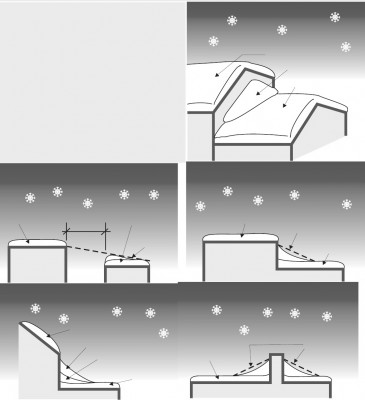Here in Vermont we really see it all when it comes to what rains down from the sky and onto our roofs. Rain, snow, sleet, freezing rain, frogs, tree limbs. It seems that the severity of what our roofs deal with has increased in recent years. This winter I have observed lots of snow rakes in action. This is when the homeowner is concerned about too much snow on the roof. The concern may be the weight of the snow or ice dams. Alex Wilson wrote an article in EBN as well as in the local paper titled "Drive by Energy Audits" the title says it all.
This is when the homeowner is concerned about too much snow on the roof. The concern may be the weight of the snow or ice dams. Alex Wilson wrote an article in EBN as well as in the local paper titled "Drive by Energy Audits" the title says it all.
Traditionally metal or slate roofs with a steep enough pitch shed snow. Often all at once with a seismic whump. In the past few years we have seen more freezing rain which turns the metal or slate into sandpaper which then holds the snow, allowing it to build up to dangerous levels. Valleys and dormers exacurbate the problem by allowing more snow to build up in an uneven loading situation and creating areas where heat can migrate out from inside, melting snow which then flows downhill until it refreezes again - Ice dams.
This brings me to the discussion of what constitutes a problem free roof. A large shallow pitch roof (1 to 5 in 12) with an EPDM membrane or slippery metal can be problematic. below a certain pitch, shingles are no longer an option and slippery materials really do not have enough pitch to shed consistently allowing snow to build up to dangerous levels. Dangerous in terms of what happens when the snow does let go.
 Steeper pitched metal roofs tend to let snow slide more often, preventing a serious buildup - unless a valley or dormer prevents this from happening.
Steeper pitched metal roofs tend to let snow slide more often, preventing a serious buildup - unless a valley or dormer prevents this from happening.
With modern EPDM or PVC roofing I am starting to think that flat (1/4" per foot to 1" per foot pitch) roofs with little or no over hang represent the best long term low maintenance option in our climate. I expect to get jumped on here) Let me explain: Any new roof is required to be structurally designed to hold a large amount of snow (snow load) as specified in local codes even if it is a steeply pitched metal roof. So no new roof should have to be shoveled or raked because of loading issues. The other issue is ice. A flat roof allows for a simplified structure with less opportunity for weak areas of insulation due to thermal bridging or difficult to insulate areas where heat can melt snow. There is also less opportunity for snow to build up unevenly. There is also less likelihood for snow to slide - It can just stay up there until spring when it melts fairly evenly. I also like the idea that a membrane is one large piece of material with a long life span if well treated (this means don't go up there and walk around especially with a shovel) Whereas all the other roofing materials are made up of hundreds of seams representing hundreds of opportunities for water to get in. If a flat roof is not an option just try to keep it simple - design a fairly steep pitch, avoid valleys and dormers, pay close attention to air sealing details and insulate to r60 consistently across the whole roof. A technique I use on the sidewall of dormers is to treat it as roof not wall in terms of the amount of insulation. I add rigid foam to the sidewalls of dormers to lessen snowmelt there. Lower shallow pitched roofs such as a porch roof need to be designed to hold much more snow than code. This is addressed in engineering manuals and code books but are often ignored by the average builder.




